Data Warehouses, Mining, and Business Intelligence for Trend Analysis
VerifiedAdded on 2023/06/08
|6
|1005
|142
Essay
AI Summary
This essay provides a comprehensive comparison between relational databases optimized for online transactions (OLTP) and data warehouses optimized for processing and summarizing large amounts of data (OLAP). It highlights the key structural differences and contrasts database requirements for operational data versus decision support data, focusing on aspects like time span, level of aggregation, and dimensionality. The essay also presents practical examples of how databases, data warehouses, and data mining can be used to support decision-making, data processing, and trend analysis within large organizational environments, such as leveraging Twitter's database architecture, regional data comparison for managerial decisions, and fraud detection in telecommunications.
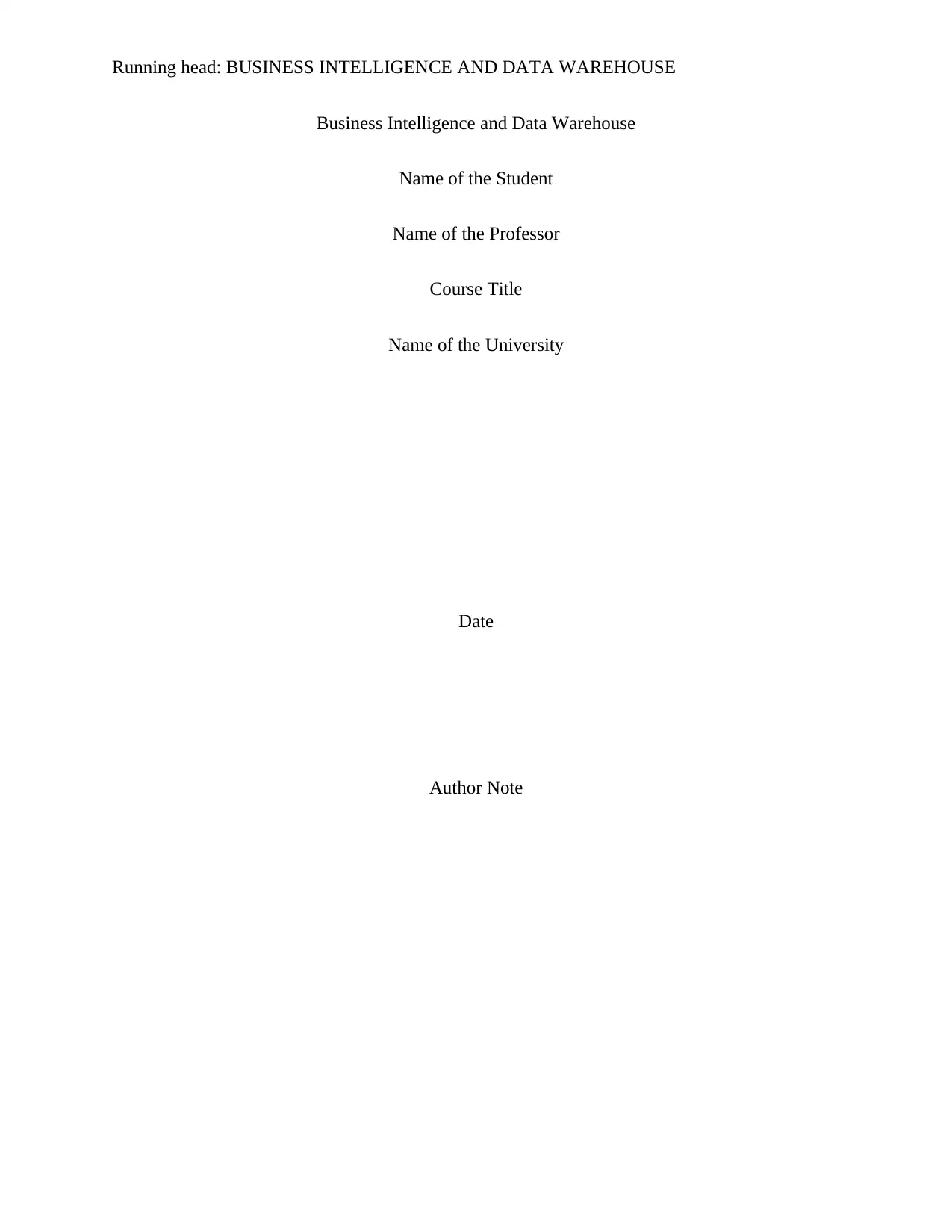
Running head: BUSINESS INTELLIGENCE AND DATA WAREHOUSE
Business Intelligence and Data Warehouse
Name of the Student
Name of the Professor
Course Title
Name of the University
Date
Author Note
Business Intelligence and Data Warehouse
Name of the Student
Name of the Professor
Course Title
Name of the University
Date
Author Note
Paraphrase This Document
Need a fresh take? Get an instant paraphrase of this document with our AI Paraphraser
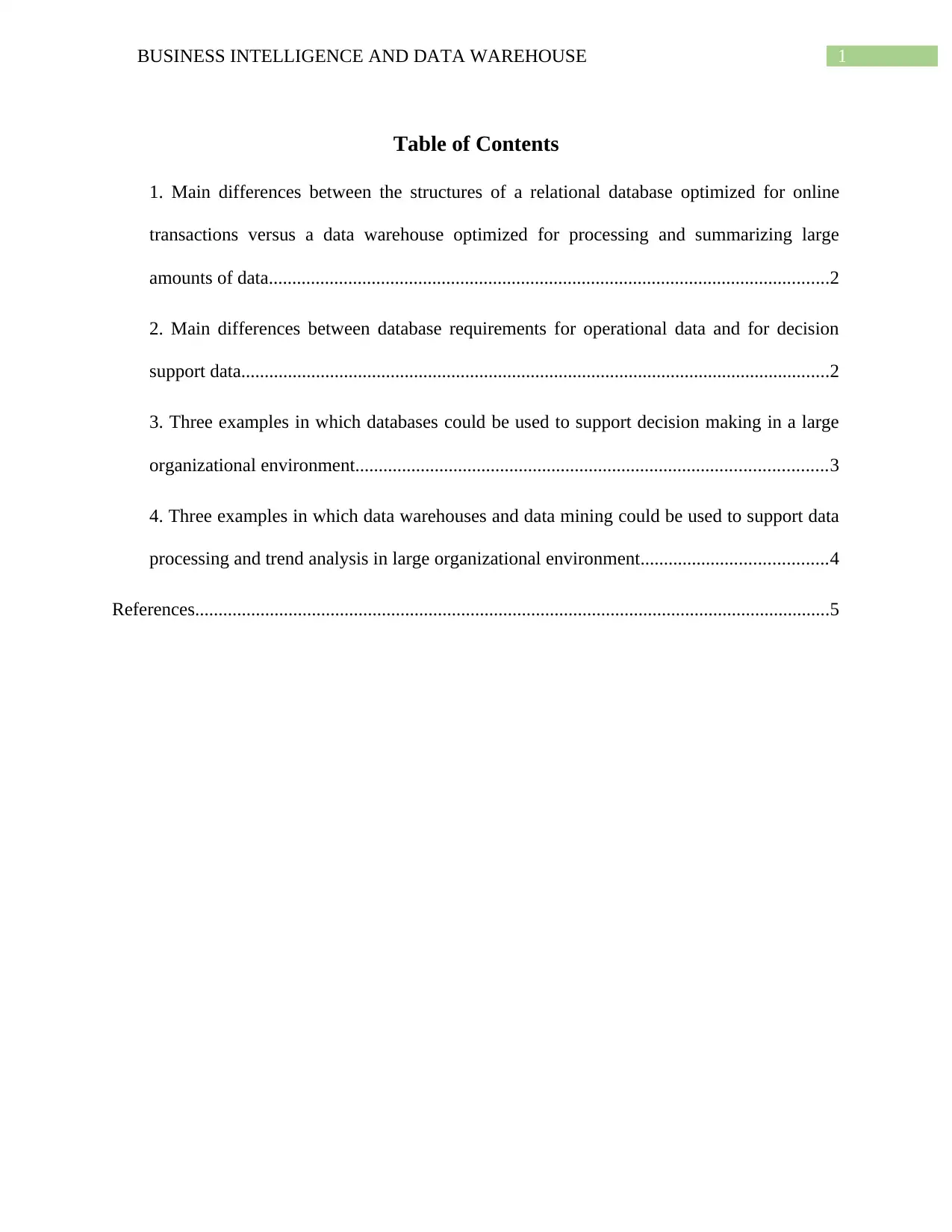
1BUSINESS INTELLIGENCE AND DATA WAREHOUSE
Table of Contents
1. Main differences between the structures of a relational database optimized for online
transactions versus a data warehouse optimized for processing and summarizing large
amounts of data........................................................................................................................2
2. Main differences between database requirements for operational data and for decision
support data..............................................................................................................................2
3. Three examples in which databases could be used to support decision making in a large
organizational environment.....................................................................................................3
4. Three examples in which data warehouses and data mining could be used to support data
processing and trend analysis in large organizational environment........................................4
References........................................................................................................................................5
Table of Contents
1. Main differences between the structures of a relational database optimized for online
transactions versus a data warehouse optimized for processing and summarizing large
amounts of data........................................................................................................................2
2. Main differences between database requirements for operational data and for decision
support data..............................................................................................................................2
3. Three examples in which databases could be used to support decision making in a large
organizational environment.....................................................................................................3
4. Three examples in which data warehouses and data mining could be used to support data
processing and trend analysis in large organizational environment........................................4
References........................................................................................................................................5
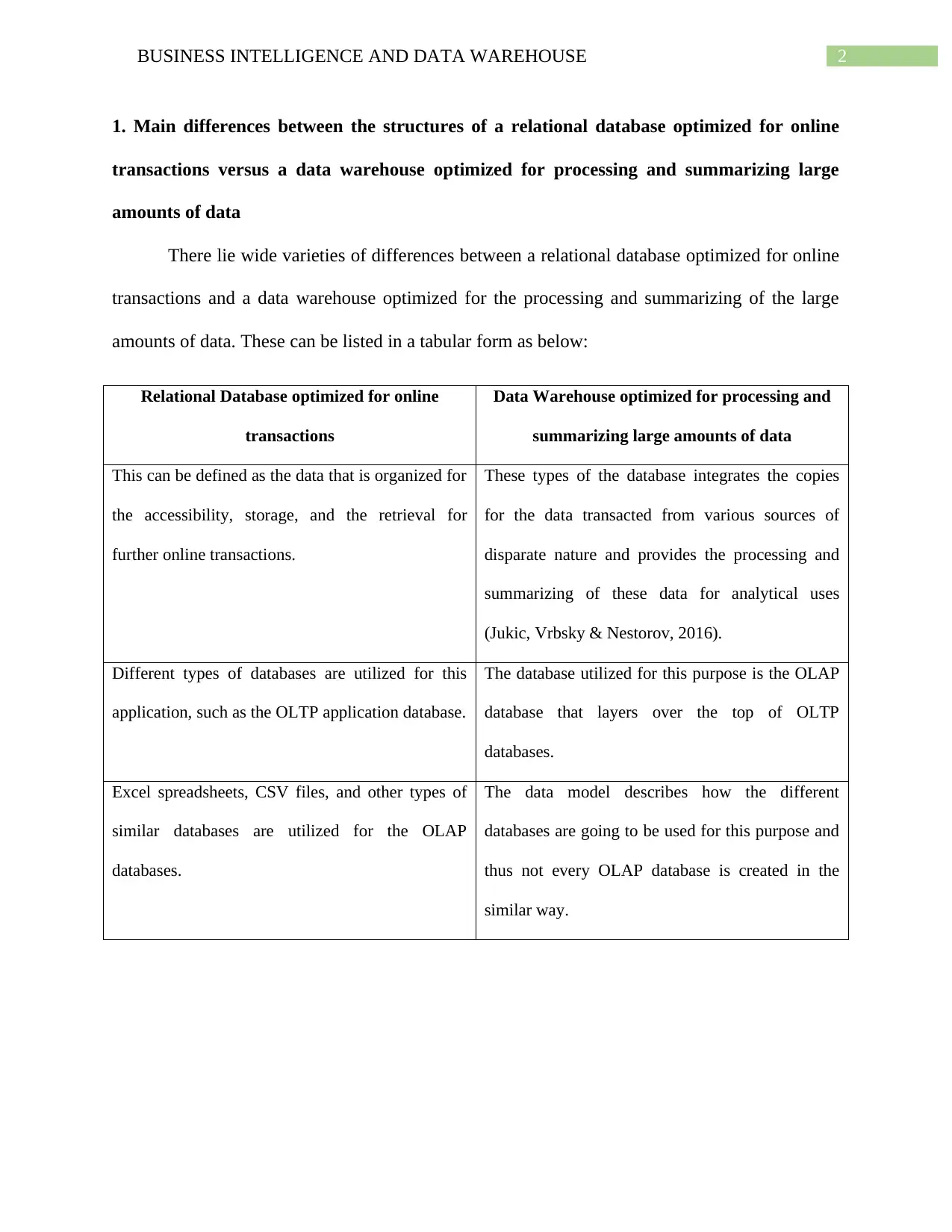
2BUSINESS INTELLIGENCE AND DATA WAREHOUSE
1. Main differences between the structures of a relational database optimized for online
transactions versus a data warehouse optimized for processing and summarizing large
amounts of data
There lie wide varieties of differences between a relational database optimized for online
transactions and a data warehouse optimized for the processing and summarizing of the large
amounts of data. These can be listed in a tabular form as below:
Relational Database optimized for online
transactions
Data Warehouse optimized for processing and
summarizing large amounts of data
This can be defined as the data that is organized for
the accessibility, storage, and the retrieval for
further online transactions.
These types of the database integrates the copies
for the data transacted from various sources of
disparate nature and provides the processing and
summarizing of these data for analytical uses
(Jukic, Vrbsky & Nestorov, 2016).
Different types of databases are utilized for this
application, such as the OLTP application database.
The database utilized for this purpose is the OLAP
database that layers over the top of OLTP
databases.
Excel spreadsheets, CSV files, and other types of
similar databases are utilized for the OLAP
databases.
The data model describes how the different
databases are going to be used for this purpose and
thus not every OLAP database is created in the
similar way.
1. Main differences between the structures of a relational database optimized for online
transactions versus a data warehouse optimized for processing and summarizing large
amounts of data
There lie wide varieties of differences between a relational database optimized for online
transactions and a data warehouse optimized for the processing and summarizing of the large
amounts of data. These can be listed in a tabular form as below:
Relational Database optimized for online
transactions
Data Warehouse optimized for processing and
summarizing large amounts of data
This can be defined as the data that is organized for
the accessibility, storage, and the retrieval for
further online transactions.
These types of the database integrates the copies
for the data transacted from various sources of
disparate nature and provides the processing and
summarizing of these data for analytical uses
(Jukic, Vrbsky & Nestorov, 2016).
Different types of databases are utilized for this
application, such as the OLTP application database.
The database utilized for this purpose is the OLAP
database that layers over the top of OLTP
databases.
Excel spreadsheets, CSV files, and other types of
similar databases are utilized for the OLAP
databases.
The data model describes how the different
databases are going to be used for this purpose and
thus not every OLAP database is created in the
similar way.
⊘ This is a preview!⊘
Do you want full access?
Subscribe today to unlock all pages.

Trusted by 1+ million students worldwide
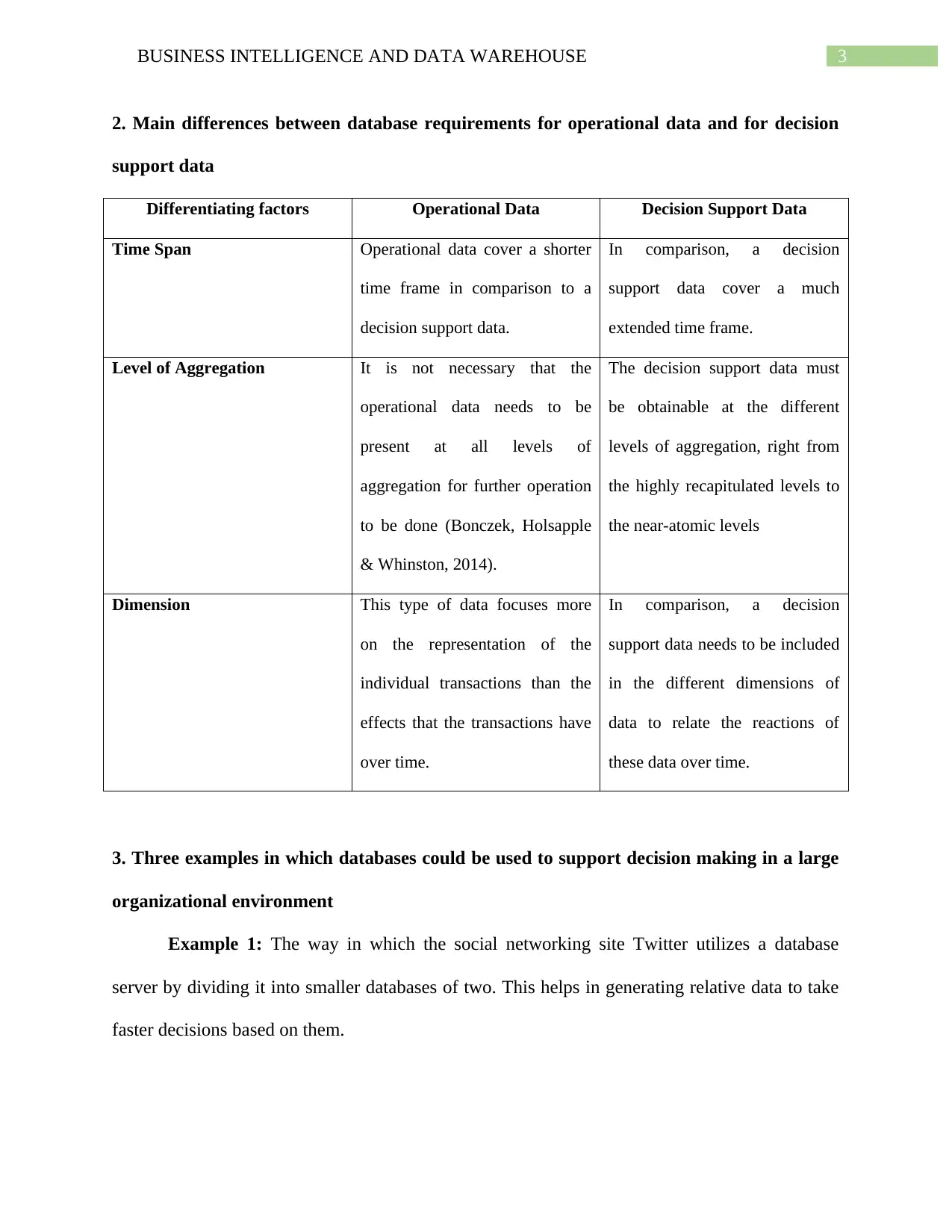
3BUSINESS INTELLIGENCE AND DATA WAREHOUSE
2. Main differences between database requirements for operational data and for decision
support data
Differentiating factors Operational Data Decision Support Data
Time Span Operational data cover a shorter
time frame in comparison to a
decision support data.
In comparison, a decision
support data cover a much
extended time frame.
Level of Aggregation It is not necessary that the
operational data needs to be
present at all levels of
aggregation for further operation
to be done (Bonczek, Holsapple
& Whinston, 2014).
The decision support data must
be obtainable at the different
levels of aggregation, right from
the highly recapitulated levels to
the near-atomic levels
Dimension This type of data focuses more
on the representation of the
individual transactions than the
effects that the transactions have
over time.
In comparison, a decision
support data needs to be included
in the different dimensions of
data to relate the reactions of
these data over time.
3. Three examples in which databases could be used to support decision making in a large
organizational environment
Example 1: The way in which the social networking site Twitter utilizes a database
server by dividing it into smaller databases of two. This helps in generating relative data to take
faster decisions based on them.
2. Main differences between database requirements for operational data and for decision
support data
Differentiating factors Operational Data Decision Support Data
Time Span Operational data cover a shorter
time frame in comparison to a
decision support data.
In comparison, a decision
support data cover a much
extended time frame.
Level of Aggregation It is not necessary that the
operational data needs to be
present at all levels of
aggregation for further operation
to be done (Bonczek, Holsapple
& Whinston, 2014).
The decision support data must
be obtainable at the different
levels of aggregation, right from
the highly recapitulated levels to
the near-atomic levels
Dimension This type of data focuses more
on the representation of the
individual transactions than the
effects that the transactions have
over time.
In comparison, a decision
support data needs to be included
in the different dimensions of
data to relate the reactions of
these data over time.
3. Three examples in which databases could be used to support decision making in a large
organizational environment
Example 1: The way in which the social networking site Twitter utilizes a database
server by dividing it into smaller databases of two. This helps in generating relative data to take
faster decisions based on them.
Paraphrase This Document
Need a fresh take? Get an instant paraphrase of this document with our AI Paraphraser
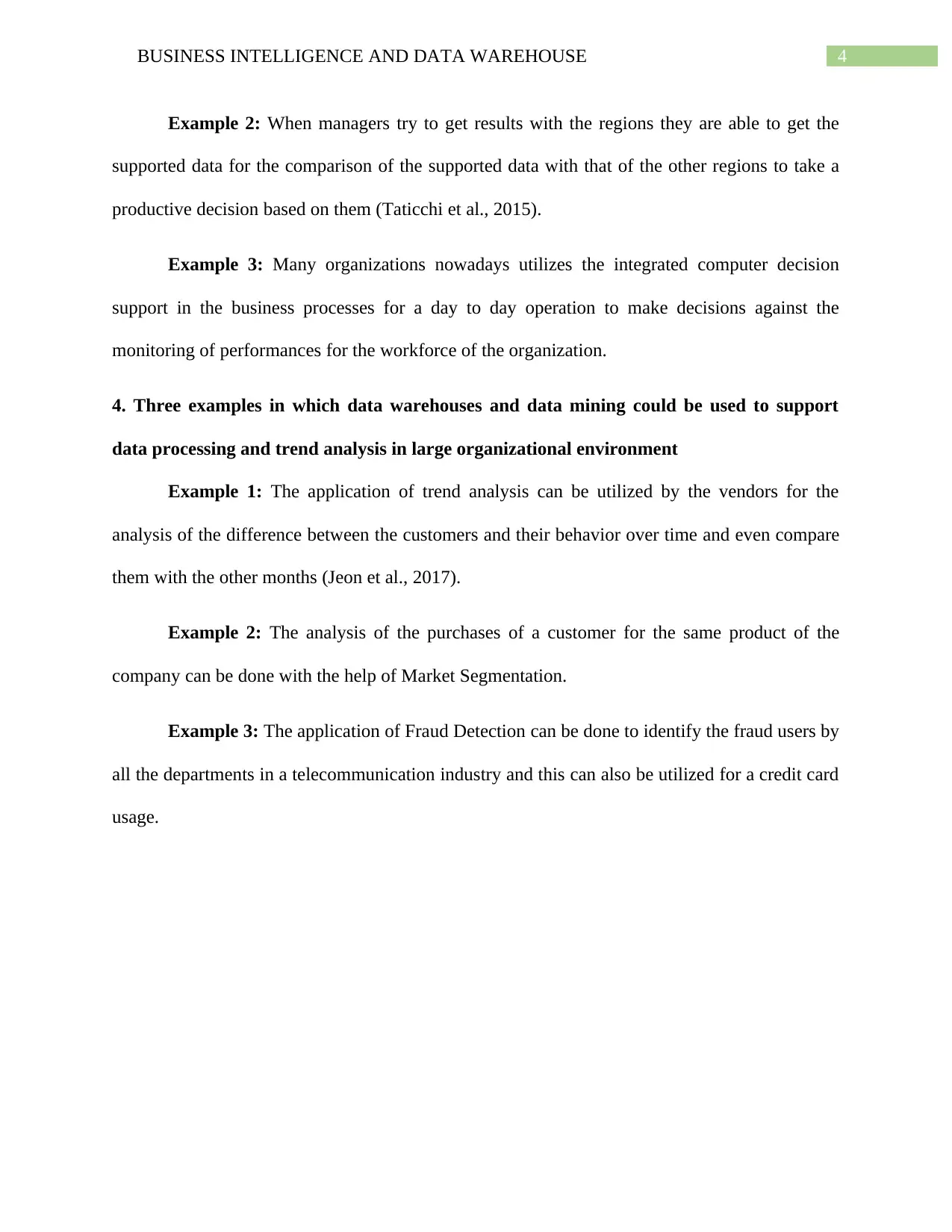
4BUSINESS INTELLIGENCE AND DATA WAREHOUSE
Example 2: When managers try to get results with the regions they are able to get the
supported data for the comparison of the supported data with that of the other regions to take a
productive decision based on them (Taticchi et al., 2015).
Example 3: Many organizations nowadays utilizes the integrated computer decision
support in the business processes for a day to day operation to make decisions against the
monitoring of performances for the workforce of the organization.
4. Three examples in which data warehouses and data mining could be used to support
data processing and trend analysis in large organizational environment
Example 1: The application of trend analysis can be utilized by the vendors for the
analysis of the difference between the customers and their behavior over time and even compare
them with the other months (Jeon et al., 2017).
Example 2: The analysis of the purchases of a customer for the same product of the
company can be done with the help of Market Segmentation.
Example 3: The application of Fraud Detection can be done to identify the fraud users by
all the departments in a telecommunication industry and this can also be utilized for a credit card
usage.
Example 2: When managers try to get results with the regions they are able to get the
supported data for the comparison of the supported data with that of the other regions to take a
productive decision based on them (Taticchi et al., 2015).
Example 3: Many organizations nowadays utilizes the integrated computer decision
support in the business processes for a day to day operation to make decisions against the
monitoring of performances for the workforce of the organization.
4. Three examples in which data warehouses and data mining could be used to support
data processing and trend analysis in large organizational environment
Example 1: The application of trend analysis can be utilized by the vendors for the
analysis of the difference between the customers and their behavior over time and even compare
them with the other months (Jeon et al., 2017).
Example 2: The analysis of the purchases of a customer for the same product of the
company can be done with the help of Market Segmentation.
Example 3: The application of Fraud Detection can be done to identify the fraud users by
all the departments in a telecommunication industry and this can also be utilized for a credit card
usage.
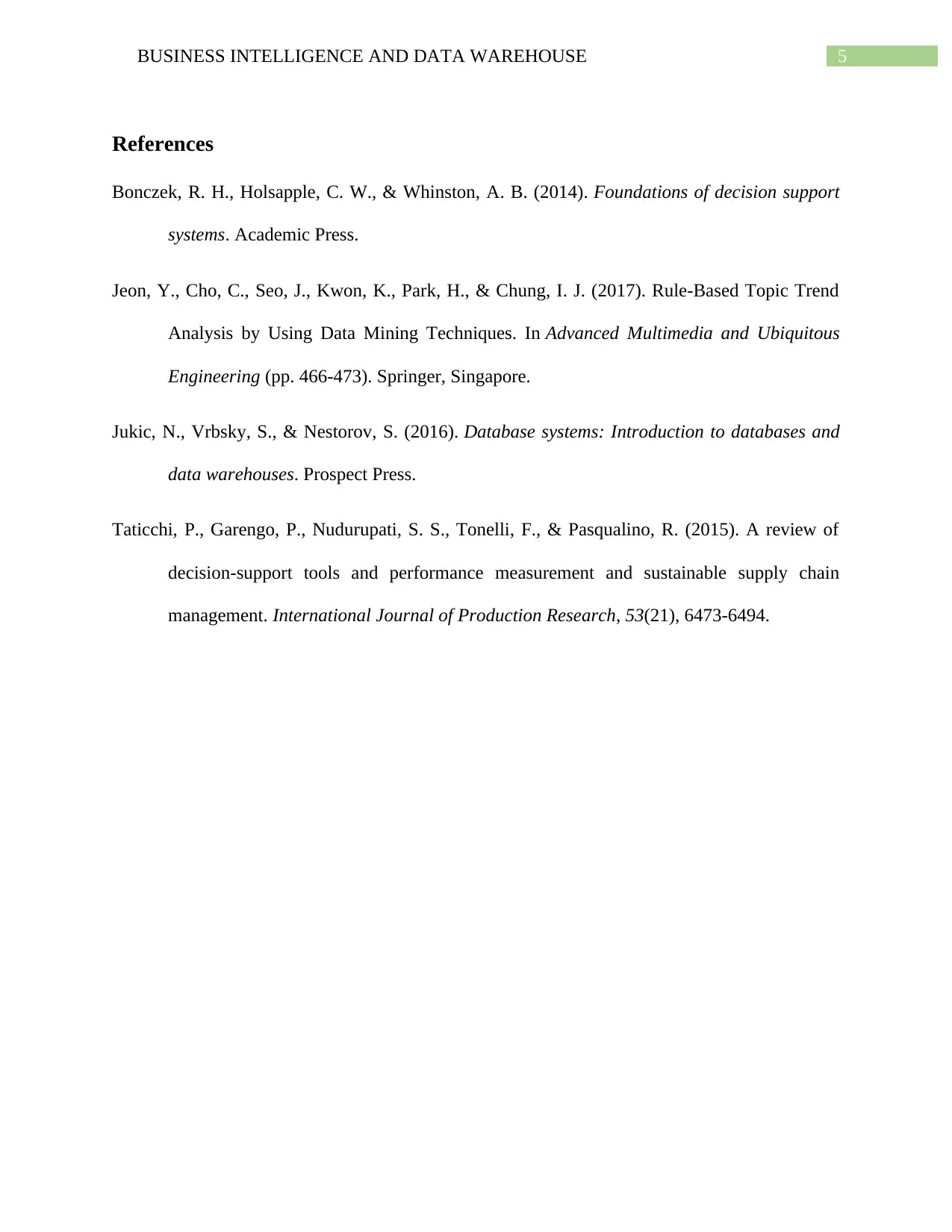
5BUSINESS INTELLIGENCE AND DATA WAREHOUSE
References
Bonczek, R. H., Holsapple, C. W., & Whinston, A. B. (2014). Foundations of decision support
systems. Academic Press.
Jeon, Y., Cho, C., Seo, J., Kwon, K., Park, H., & Chung, I. J. (2017). Rule-Based Topic Trend
Analysis by Using Data Mining Techniques. In Advanced Multimedia and Ubiquitous
Engineering (pp. 466-473). Springer, Singapore.
Jukic, N., Vrbsky, S., & Nestorov, S. (2016). Database systems: Introduction to databases and
data warehouses. Prospect Press.
Taticchi, P., Garengo, P., Nudurupati, S. S., Tonelli, F., & Pasqualino, R. (2015). A review of
decision-support tools and performance measurement and sustainable supply chain
management. International Journal of Production Research, 53(21), 6473-6494.
References
Bonczek, R. H., Holsapple, C. W., & Whinston, A. B. (2014). Foundations of decision support
systems. Academic Press.
Jeon, Y., Cho, C., Seo, J., Kwon, K., Park, H., & Chung, I. J. (2017). Rule-Based Topic Trend
Analysis by Using Data Mining Techniques. In Advanced Multimedia and Ubiquitous
Engineering (pp. 466-473). Springer, Singapore.
Jukic, N., Vrbsky, S., & Nestorov, S. (2016). Database systems: Introduction to databases and
data warehouses. Prospect Press.
Taticchi, P., Garengo, P., Nudurupati, S. S., Tonelli, F., & Pasqualino, R. (2015). A review of
decision-support tools and performance measurement and sustainable supply chain
management. International Journal of Production Research, 53(21), 6473-6494.
⊘ This is a preview!⊘
Do you want full access?
Subscribe today to unlock all pages.

Trusted by 1+ million students worldwide
1 out of 6
Related Documents
Your All-in-One AI-Powered Toolkit for Academic Success.
+13062052269
info@desklib.com
Available 24*7 on WhatsApp / Email
![[object Object]](/_next/static/media/star-bottom.7253800d.svg)
Unlock your academic potential
Copyright © 2020–2025 A2Z Services. All Rights Reserved. Developed and managed by ZUCOL.



